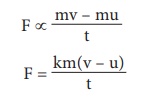Chapter: 10th Science : Chapter 1 : Laws of Motion
NewtonŌĆÖs Second Law of Motion
NEWTONŌĆÖS SECOND LAW OF
MOTION
According to this law,
ŌĆ£the force acting on a body is directly proportional to the rate of change of
linear momentum of the body and the change in momentum takes place in the
direction of the forceŌĆØ.
This law helps us to
measure the amount of force. So, it is also called as ŌĆślaw of forceŌĆÖ.
Let, ŌĆśmŌĆÖ be the mass of a moving body, moving along a straight line with an
initial speed ŌĆśuŌĆÖ After a time interval of ŌĆśtŌĆÖ, the velocity of the body
changes to ŌĆśvŌĆÖ due to the impact of an unbalanced external force F.
Initial momentum of the
body Pi = mu
Final momentum of the
body Pf = mv
Change in momentum Δp =
Pf ŌĆōPi
= mv ŌĆō mu
By NewtonŌĆÖs second law
of motion,
Force, F ŌłØ
rate of change of momentum
F ŌłØ
change in momentum / time

Here, k is the
proportionality constant. k = 1 in all systems of units. Hence,

Since, acceleration =
change in velocity/ time, a=(v-u)/t. Hence, we have
F = m ├Ś a (1.6)
Force = mass ├Ś acceleration
No
external force is required to maintain the motion of a body moving with uniform
velocity. When the net force acting on a body is not equal to zero, then
definitely the velocity of the body will change. Thus, change in momentum takes
place in the direction of the force. The change may take place either in
magnitude or in direction or in both.
Force is required to produce the acceleration of a
body. In a uniform circular motion, even though the speed (magnitude of
velocity) remains constant, the direction of the velocity changes at every
point on the circular path. So, the acceleration is produced along the radius
called as centripetal acceleration.
The force, which produces this acceleration is called as centripetal force,
about which you have learnt in class IX.
Units of
force: SI unit of force is newton (N) and
in C.G.S system its unit is dyne.
Definition of 1 newton (N): The amount
of force required for a body of mass 1 kg produces an acceleration of 1 m sŌĆō2, 1 N = 1 kg m sŌĆō2
Definition of 1
dyne: The amount of force required for a body of mass 1 gram produces an
acceleration of 1 cm sŌĆō2, 1 dyne = 1 g cm sŌĆō2; also 1 N = 105 dyne.
Unit force:
The amount of force required
to produce an acceleration of 1 m sŌĆō2 in a body of mass kg is
called ŌĆśunit forceŌĆÖ.
Gravitational unit of
force:
In the SI system of
units, gravitational unit of force is kilogram force, represented by kg f. In
the CGS system its unit is gram force, represented by g f.
1 kg f = 1 kg ├Ś 9.8 m s-2
= 9.8 N;
1 g f = 1 g ├Ś 980 cm s-2
= 980 dyne
Related Topics